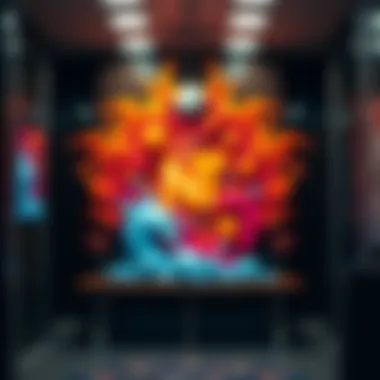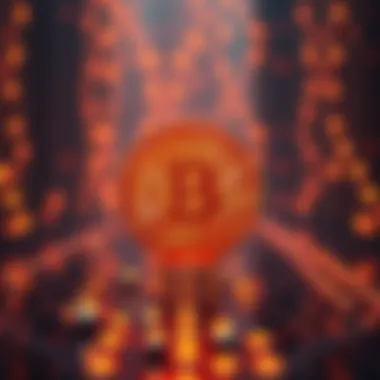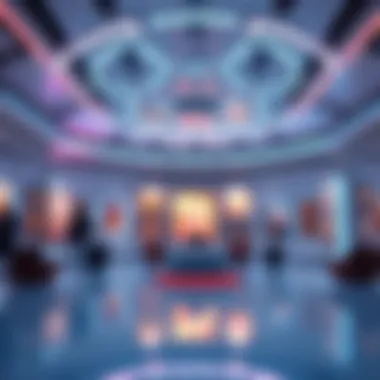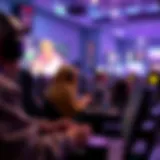Exploring the NFT Art Landscape: Evolution and Impact


Intro
In today’s digital age, the landscape of art is shifting dramatically, and Non-Fungible Tokens (NFTs) are at the forefront of this evolution. As part of a broader blockchain movement, NFTs have fundamentally altered how artists create, exhibit, and sell their work. This transformation is capturing the attention of an eclectic mix of investors, collectors, and admirers, who are eager to navigate this enthralling domain.
The concept of representing ownership and authenticity through blockchain technology is still relatively new, yet its impact is reverberating throughout the art market. Artists, regardless of their past experience or reputation, are finding new avenues for self-expression, while collectors have a unique opportunity to acquire and own digital pieces that were previously difficult to purchase.
Despite the emergence of these digital assets, the complexities of NFTs can be overwhelming. Discussions about their future, market trends, and the legal aspects of ownership seem to float around like confetti at a parade—exciting but challenging to navigate without a proper guide.
In this article, we will delve into multiple facets of NFT art, exploring not only its vibrant market dynamics but also providing insight into effective investment strategies. The intention is to arm both seasoned investors and curious newcomers with the knowledge they need to engage confidently in this rapidly evolving artistic and financial landscape.
Understanding NFT Art
The emergence of NFT art has stirred conversations across various spheres, from tech junkies to traditional art collectors. Getting a grasp on what NFT art actually is not just a nice-to-have knowledge, but a necessity for anyone wishing to navigate this complicated yet thrilling landscape. It transcends being merely buzzworthy; it embodies a shift in how we perceive ownership, authenticity, and value in art.
When diving into the ocean of NFT art, it becomes imperative to acknowledge certain key elements. One important aspect to keep in mind is the potential that NFT art holds for artists and collectors alike. For artists, NFTs can serve as a powerful tool for monetization, allowing them to connect directly with audiences without the need for intermediaries like galleries or auction houses. This direct relationship can transform the entire art market landscape.
For collectors, NFTs offer an intriguing way to own pieces of digital art that, once upon a time, were merely intangible. The proof of ownership is encoded into the blockchain, where the art piece's authenticity never gets lost, even if the original creator sells countless iterations or prints.
However, while potential flourishes, so do challenges. Issues surrounding copyright, speculation, and market volatility loom large over the NFT space. Investors need to be vigilant, doing their due diligence in research. Unequivocally understanding NFT art involves grappling with both its innovative aspects and its inherent pitfalls. It’s like walking a tightrope: on one side, the allure of new forms of expression; on the other, the risk of getting tangled in regulatory ambiguity or financial losses.
In essence, understanding NFT art is about more than just recognizing its trendiness—it's about seeing the opportunities and anticipating the hurdles. It’s crucial for anyone wishing to invest time or money in this space. With that glance at the significance of grasping NFT art, let’s dig deeper into the definitions and nuances surrounding this fascinating subject.
Defining NFTs in the Art World
NFTs, or non-fungible tokens, have exploded in popularity, yet confusion often cloaks what they truly represent. In the art world, NFTs function as digital certificates of authenticity and ownership for one-of-a-kind pieces of art or collectibles. Instead of being interchangeable like typical currencies, each NFT is unique and irreplaceable, much like a quintessential painting by Van Gogh or an original photograph by Ansel Adams. This distinctiveness is vital; it assures buyers that what they own is both rare and verifiable.
In practical terms, an NFT can be anything from a digital painting to music files or even tweets—that’s right, a tweet can be sold as an NFT. Artists mint their creations and list them for sale on various platforms, allowing collectors to bid on or purchase them outright. Yet, buyers should be wary. The token doesn’t necessarily grant the buyer copyright over the work, something that is often misunderstood and leads to further complications in ownership discussions.
"The rise of NFTs prompts art enthusiasts to reevaluate what it means to own a piece of art in the digital age."
The Intersection of Technology and Creativity
At the crossroads of technology and creativity lies a potent blend that defines the NFT art landscape. The backbone of NFTs is blockchain technology, ensuring security and transparency, foundational elements that traditional art markets often lacked. This democratization is nothing short of revolutionary. Taking the power of distribution and verification away from gatekeepers is a game-changer for artists.
Furthermore, artists can leverage new tools to create more interactive and immersive experiences. Imagine an artwork that changes based on viewer interaction or an animation that responds in real time. Technology expands the palette available to artists, allowing them to engage audiences in innovative ways.
While the connection between technology and art can yield incredible results, the integration can also present challenges. Some artists may struggle with the technical aspects of minting NFTs or promoting their work on digital platforms, leading to missed opportunities. Thus, a balance must be struck—embracing the tools offered by technology while not losing the essence and emotive power of creativity.
As we embark on this exploration of NFT art, it’s vital to navigate this rich and evolving landscape with intent, insight, and an eye towards understanding both the art and the technology behind it. This will set the stage for deeper dives into the evolution of digital art and market dynamics that follow.
The Evolution of Digital Art
The world of art has always been a reflection of its time, adapting to shifts in culture, technology, and society. In recent years, digital art has come to the forefront, reshuffling how art is created, disseminated, and consumed. This evolution is not just a minor shift; it represents a dramatic transformation in the landscape of artistic expression, and it’s integral to understanding NFT art. The intersection of traditional and new media presents both challenges and opportunities, impacting artists and collectors alike.
From Traditional to Digital Medium
As artists gradually transitioned from canvas to screens, the methods and tools they employ have evolved as well. In the past, creating art required physical materials—paints, brushes, and canvases—but today, artists can express themselves using software and digital devices. The rise of tools like Adobe Photoshop, Procreate, and Corel Painter allows for limitless experimentation.
This shift has democratized art creation; anyone with a computer can create and share their works globally. The tactile experience of traditional mediums is traded for the fluidity and editability that digital offers. While traditionalists may argue that something is lost in this conversion, many artists relish the new freedom and options at their disposal. However, not all are on board with this transition. Some circles remain skeptical, worried that
- digital art lacks the 'soul' found in physical pieces.
- the ease of copying and sharing undermines the concept of originality.
Yet, this very fluidity is also a boon: it allows for collaborative projects, expansive portfolios, and art that interacts with its audience in ways previously unimaginable. Virtual reality art installations, animated pieces, and augmented reality experiences aren’t just novelties; they push the narrative of what art can be.
Birth of NFTs: A Brief History


The journey of NFTs in the art sphere is uniquely significant. Although the concept of digital ownership existed for a while, it wasn't until 2017 that NFTs made headlines with major sales.
In early 2017, a digital artist named Kevin McCoy created 'Quantum,' a simple but groundbreaking piece; but it wasn’t until projects like CryptoKitties gained popularity that NFTs began to take shape in the public eye. Collectors recognized the potential of owning unique digital assets secured by blockchain technology. This means that, unlike previous digital art forms, NFTs confer legitimacy and ownership, transforming how artists monetize their work.
Some key milestones since the inception of NFTs include:
- 2017: Launch of CryptoKitties, introducing pixelated cats that can be bred and traded.
- 2020: Boom in NFT marketplace platforms like Rarible and OpenSea, allowing artists to mint and sell their own creations.
- 2021: Beeple sells a digital collage for an eye-popping $69 million at Christie's, signaling mainstream adoption.
Together, these shifts underscore how the art world is abuzz with new possibilities. For every challenge posed, there's an innovative artist or platform ready to tackle it, ensuring that the evolution of digital art continues to unfold in fascinating, unexpected ways.
Market Dynamics of NFT Art
The market dynamics of NFT art are not merely a sideshow in the grand theater of digital art; they are akin to the weather patterns that dictate the flow of rivers. Understanding these dynamics is crucial as they hold significant implications for artists, investors, and collectors alike. This understanding explores the intricate relationship between supply and demand, economic principles, and emerging trends that define the economics of NFT art.
Analyzing Sales Patterns and Trends
As the NFT art market has burgeoned, tracking sales patterns provides invaluable insights into what resonates with buyers. For instance, platforms like OpenSea and Rarible have witnessed shifts in buyer preferences based on various factors. The allure of some pieces often hinges on the artist's previous work, the uniqueness of the NFT, and, oddly enough, the time of year. Notable spikes in sales have been observed during significant events, such as art fairs or tech conferences, suggesting that community engagement boosts interest and sales.
- Diverse Price Ranges: NFTs can sell for a broad spectrum of prices. Some works fetch astronomical figures, while many remain accessible for newcomers. This variation caters to a range of collectors, from seasoned investors to novices seeking affordable pieces.
- Platform Influences: Different platforms often emphasize varying sales strategies, from auctions to fixed-price listings. Studying how these choices affect sales outcomes can reveal which methods align best with consumer preferences.
Key Players and Platforms
The NFT landscape is populated by numerous key players and platforms that are shaping its trajectory. Blockchaining technology underpins much of this space, enabling secure transactions and provenance tracking. Here are some notable platforms:
- OpenSea: One of the largest marketplaces where users can buy and sell a vast array of digital collectibles. It offers robust tools for both artists and buyers, making it a go-to for many.
- SuperRare: Tailored towards discerning collectors, SuperRare focuses on high-end digital art, emphasizing quality and exclusivity over quantity.
- Foundation: Creating a community-driven marketplace, artists need to be invited to sell on this platform, which helps create a sense of scarcity and exclusivity. This might drive prices upward.
The ongoing interplay between these platforms is pivotal. Different platforms might cultivate distinctive communities, affecting artist visibility and market perceptions.
Investor Behavior in NFT Markets
Understanding how investors behave within the NFT market mirrors analyzing consumer behavior in traditional finance. Many investors approach NFT art not just as a form of investment but as a cultural and emotional engagement with the art itself. Some notable behaviors emerge:
- Speculation vs. Long-term Holding: Some investors buy with the hope of flipping for a quick profit, while others collect as long-term investments, banking on the artist’s future growth.
- Volatility Acceptance: Just like in stocks, the NFT art market can see rapid price swings. This offers opportunities but also calls for measured risk assessment, requiring investors to tread carefully.
- Cultural Connection: Many buyers develop an emotional bond with the art or the artist, a dimension that can influence investment decisions.
As the market continues to evolve, the interaction of these factors—sales patterns, platforms, and investor behavior—creates a complex but vibrant landscape for NFT art. The understanding of these dynamics is crucial for anyone looking to navigate this exciting territory, be it artist, collector, or investor.
"In the world of NFT art, what you know can make all the difference—understanding the market dynamics is akin to having the ultimate cheat code at your fingertips."
For further reading on NFT market trends, you can check out resources like Wikipedia or Britannica for foundational knowledge.
The Artist’s Perspective
NFT art has emerged as a transformative force in the creative landscape, reshaping how artists approach their work and engage with audiences. Understanding the artist's perspective is crucial because it provides insight into not just the mechanics behind NFTs but also the emotional and economic implications for creators. The digital revolution has democratized art, allowing artists from various backgrounds to showcase their work without the traditional gatekeepers of galleries and auction houses. This newfound freedom gives artists a platform to connect directly with collectors and fans, fostering a sense of autonomy.
Creating Art in the NFT Space
Creating art specifically for the NFT space involves a blend of innovation and strategic thinking. It’s not just about making beautiful pieces but also understanding how digital ownership and smart contracts function. Artists need to grasp concepts such as metadata and blockchain technology to effectively market their work.
For example, consider an artist who produces an animated digital painting. The way this piece can be coded, allowing for specific interactions or layers of ownership—such as limited editions or unlockable content—turns a traditional art piece into an immersive experience. Additionally, platforms like OpenSea or Rarible provide tools that simplify the minting process, yet artists must still navigate creating content that holds value in the saturated NFT market. Therefore, the blend of artistic creativity with technical acumen is essential.
Monetization Strategies for Artists
One of the most enticing aspects of NFTs is the potential for profitability. Various monetization strategies have emerged, offering artists different ways to earn from their work:
- Royalties: Artists can set up smart contracts to receive a percentage of future sales every time their NFT changes hands, ensuring ongoing revenue from their original creations.
- Crowdfunding: Some artists use platforms to fund their projects, offering early backers limited edition NFTs or unique perks, effectively generating upfront capital.
- Merchandising Digital Assets: Artists have the option to create items or experiences related to their NFTs, like prints or exclusive live-streamed events.
Innovating with these strategies, artists can diversify their income streams while enriching the collector's experience. For instance, an artist who sells their NFT along with a physical artwork can create a tangible connection, further enhancing value.


Challenges and Opportunities
The NFT landscape is not without its pitfalls. Artists face several challenges including:
- Market Saturation: With the rapid growth of the NFT market, it’s tough to stand out. Many artists find their works lost in the noise, leading to the necessity of effective branding and promotion.
- Technological Barriers: Not all artists are equipped with the technical know-how to navigate the NFT space, which can hinder participation.
- Environmental Concerns: The energy consumption associated with blockchain transactions raises ethical questions, prompting some artists to seek sustainable alternatives or platforms.
However, alongside these challenges lie opportunities. As awareness of NFTs grows, so too does their acceptance in mainstream art circles. Established institutions are beginning to acknowledge and showcase NFT art, providing legitimacy and a broader audience. Furthermore, as technologies evolve, artists can anticipate more accessible tools and platforms that streamline the NFT art creation process.
In summation, navigating the NFT art world presents a complex but rewarding journey for artists. By blending creativity with an understanding of digital ownership and exploring varied monetization pathways, artists can thrive in this new ecosystem. The continuous evolution of technology means that those who adapt will find vast opportunities amid the challenges.
Legal and Ethical Considerations
In the whirlwind of NFT art's rise, legal and ethical considerations stand out as pivotal for both artists and collectors. This landscape offers a fertile ground for creativity and innovation, while also posing significant questions that need careful navigation. Understanding these aspects is not just beneficial but necessary. It helps to create a transparent, responsible, and fair environment for engaging in NFT transactions. Addressing the complexities of intellectual property rights and ownership issues ensures that artists are respected and compensated, thereby nurturing the growth of this vibrant market.
Intellectual Property Rights in NFTs
Navigating intellectual property rights in NFTs is akin to walking through a minefield where knowing the terrain is key. The artistic realm thrives on originality. When artists mint their works as NFTs, they inadvertently enter a gray area filled with legal implications. Most artists assume that by creating an NFT, they automatically retain copyright for their artwork. However, this isn’t always the case.
When an artist sells an NFT, they can retain specific rights while transferring others to the buyer. This leads to diverse scenarios. For example:
- Licensing Rights: An artist may sell an NFT while keeping the rights to reproduce their work. This allows them to earn future revenue if the piece is used commercially.
- Resale Rights: Some platforms facilitate resale, enabling artists to gain a percentage whenever their work changes hands. This is a significant shift from traditional art markets.
- Plagiarism Concerns: With the ease of digital reproduction, distinguishing original artwork from copies is crucial to uphold an artist's rights.
Artists need to be crystal clear about what they offer when selling an NFT, otherwise disputes could potentially arise when someone misuses their work. For further reading, one might check resources like Wikipedia on copyright law for thorough explanations.
The Question of Ownership
Ownership in the NFT space has several layers, layered like an onion, each peel revealing deeper nuances. When someone purchases an NFT, they acquire a unique token that signifies ownership. But what does that ownership actually entail? In many cases, buyers mistake owning the NFT for owning the artwork itself.
- Digital Asset vs. Intellectual Property: Purchasing an NFT gives the buyer rights to the token, but not necessarily the underlying intellectual property. An insightful distinction is that while you own the NFT, the original artist might retain the copyright.
- Transfer of Ownership: When an NFT is sold, rights can change hands, but understanding what rights convey with the token is less straightforward. Buyers should be meticulous, reading contracts or terms of service before diving into purchases.
- Impact on Market Value: Ownership issues also influence market dynamics. An unclear ownership structure could depress an asset's value. When consumers grasp the implications of ownership rights, they are more likely to invest wisely.
"Owning an NFT is like owning a ticket to a concert; it grants access but doesn't bestow ownership over the performance."
As this sector continues to evolve, ongoing discourse is essential in shaping laws that are reflective of the realities of digital art. Artists and buyers alike need to stay informed on these topics, perhaps considering joining forums or discussions on platforms like Reddit where such matters are frequently dissected.
The Future of NFT Art
The future of NFT art stands at a fascinating crossroads. As the digital landscape expands, understanding the trajectory of NFTs becomes crucial for artists, investors, and enthusiasts alike. The development of this domain is not merely a flash in the pan; rather, it symbolizes a significant shift in how we perceive and engage with art, driving home the convergence of technology and creativity.
Emerging Trends and Technologies
One of the most discussed trends is the proliferation of metaverse platforms. Virtual reality environments such as Decentraland and The Sandbox are enabling immersive art experiences, where NFT artworks can be exhibited in new and interactive ways. Artists can create entire worlds surrounding their pieces, allowing a deeper connection between the audience and the artwork.
Moreover, augmented reality is increasingly integrated into NFT art, enhancing the viewing experience. Imagine pointing your phone’s camera at a blank wall and watching it transform into a digital showcase of art—all backed by blockchain technology to verify ownership and authenticity.
Additionally, AI-generated art is pushing boundaries. Platforms like Artbreeder enable users to create unique works by mixing existing pieces, giving birth to a new wave of creation that blurs the line between human and machine-made art. Not only does this democratize the art-making process, but it also opens discussions about authorship and originality within the NFT space.
"As technology evolves, so does the very definition of creativity. NFTs are just the tip of the iceberg in a rapidly changing art landscape."
Sustainability Concerns
A pertinent issue surrounding NFTs is their environmental impact. Many NFTs are currently minted on proof-of-work blockchains, which consume huge amounts of energy. This has raised eyebrows, as artists and collectors become more aware of the carbon footprint associated with their transactions.
In light of these concerns, several platforms are transitioning to more eco-friendly alternatives. Ethereum 2.0 aims to shift to a proof-of-stake mechanism, drastically reducing energy consumption. Other blockchain networks, such as Tezos and Flow, offer greener solutions right from the start, attracting environmentally-conscious artists and collectors.
The challenge remains: square the balance between the fervor for digital art and the responsibility towards sustainability. As more individuals join the NFT arena, the conversation about its environmental impact has become a focal point for future developments.
Predictions for Market Growth


Looking ahead, the NFT market is projected to grow significantly. The integration of NFTs into various industries—like gaming, fashion, and music—is only in its infancy. Analysts suggest that NFTs could soon become a standard method for content distribution across platforms.
Furthermore, as traditional artists embrace digital spaces, we might see an influx of galleries aimed purely at showcasing NFT art. This can lead to increased legitimacy for digital artwork in the conventional art world, effectively bridging the gap.
Moreover, we should prepare for greater institutional involvement. Major players in finance and tech are exploring NFTs as alternative investments. This could broaden accessibility and introduce a diverse range of collectors into the market, potentially stabilizing pricing fluctuations.
In summary, the future of NFT art is poised for expansive growth, shaped by technological innovation and the pressures of sustainability. Both artists and investors must stay attuned to these dynamics to navigate this ever-evolving landscape effectively.
For those looking to delve deeper into the subject, resources such as Wikipedia, Britannica, and communities on Reddit offer insightful perspectives and continual updates.
Case Studies in NFT Art
Examining case studies within the NFT art space serves as an essential component of understanding how this vibrant and dynamic market operates. These real-world examples highlight not only the potential financial gains for artists and collectors but also showcase various challenges and ethical considerations. A thorough investigation of specific cases provides insights into consumer behavior, market trends, and the significant cultural implications of NFT art.
Successful NFT Art Sales
Successful sales of NFT artwork can be telling signs of market dynamics and consumer interest. For instance, the sale of Beeple's "Everydays: The First 5000 Days" for a staggering $69 million at Christie's auction house sent shockwaves through the art world. This sale was not just about the price; it also redefined perceptions of digital art. It illustrated how the NFT medium can elevate digital pieces to the same status as traditional artworks.
Another notable example is the project by Pak, an artist known for their unique approach to digital art. The collection called "The Merge" generated over $91 million, with buyers purchasing "mass" units that they could combine. This sale emphasized how NFT art could introduce innovative buying structures and ownership concepts.
These case studies underscore key trends such as:
- Rising Selling Prices: The record-breaking sales are reshaping the valuation of art.
- New Ownership Models: Unique approaches to ownership and structure redefine how we think about purchasing art.
- Increased Participation: The ease of purchasing NFTs has invited a broader demographic into the art world.
In the context of these sales, it's critical also to consider the technologies behind NFTs. Platforms like OpenSea and Rarible play pivotal roles in the facilitation of such sales, providing essential groundwork for artists to reach collectors efficiently.
Innovative Artists and Their Contributions
Innovative artists are pioneering the landscape of NFT art in unique ways that go beyond mere digital replication. For instance, artists like XCOPY are leading the charge with their animated graphics that often include satirical commentary on the crypto world. Their work not only captures attention but also raises questions about the nature and future of ownership in the digital realm.
Another trailblazer is Grimes, who sold a collection of digital artworks, complete with original music. Grimes’ work signifies a merging of different art forms, showcasing how artists can harness the characteristics of NFTs to reach wider audiences. This cross-pollination of disciplines is not only stimulating the art community but also extending into other sectors, including music and fashion.
Some notable contributions include:
- Experimentation: Artists are willing to push boundaries, exploring new aesthetics and methods of creation.
- Community Engagement: Many artists engage with their audience and fans directly, cultivating a sense of belonging.
- Infinite Editions: Artists like Pak are challenging traditional notions of scarcity through their editions models.
The landscape of NFT art is shaped not only by market sales but also by these visionary artists who break traditional molds. Their contributions and the community dynamics they foster highlight that the importance of NFT art extends well beyond mere financial aspects; it's about building new cultures and redefining artistic expression.
"NFTs are more than just art; they are a paradigm shift in ownership and expression."
The examination of these cases doesn't merely inform investors about profit potential; it provides a poignant reflection on how technology and art are intricately woven together in the modern world.
For further reading, consider these resources: Wikipedia on NFTs, Britannica's Overview on Digital Art, and discussion forums on Reddit regarding trends and cases in NFT art.
The End
The conclusion of this exploration into NFT art is not just an endpoint, but rather a gateway to understanding its multifaceted implications. As we wrap around the essence of NFT art, it becomes clear that these digital tokens encapsulate more than mere pixels on a screen; they embody a shift in how art is conceived, owned, and valued. In navigating the complex interplay of technology and creativity, we find that NFT art represents a microcosm of the broader digital transformation affecting various industries today.
Summarizing the Implications of NFT Art
NFT art has sparked a renaissance of sorts within the creative community, offering artists new avenues for expression and monetization. Here are some key implications to consider:
- Ownership Redefined: Unlike traditional art, where ownership can be muddled, NFTs offer a clear, verifiable lineage recorded on the blockchain. This could radically transform how collectors engage with art.
- Accessibility to a Global Market: NFTs break down geographical barriers, allowing artists from any corner of the world to showcase their work to a global audience. Conversely, collectors can discover diverse creators beyond the confines of the physical gallery.
- Empowering Artists: Many artists leveraging NFTs have reported significantly higher profits than traditional sales methods. This shift empowers creators to retain more of their earnings, particularly through features like smart contracts, which allow them to earn royalties on future sales.
"The rise of NFT art challenges established norms but also ushers in unprecedented opportunities for innovation."
Reflections on its Longevity and Impact
It’s a fair question to ponder—will NFT art endure or is it merely a transient trend? Several factors will weigh in on its longevity:
- Technological Advancements: As technology evolves, so do the capabilities and integrations of NFTs. We are likely to see more sophisticated tools and platforms that enhance the art experience.
- Market Adaptation: The art world is no stranger to change, and its ability to adapt will determine how NFT art integrates into mainstream practices. If galleries and museums embrace this digital format, it could signify a lasting legacy.
- Cultural Significance: The narratives that NFT art weaves into contemporary culture are significant. From ecological concerns to the appreciation of digital art as valid and valuable, these conversations shape the future of the art world.
In closing, while the NFT art landscape may still be riddled with ambiguity and skepticism, its potential to revolutionize art ownership, accessibility, and creator rights cannot be ignored. The lasting impact of NFT art will likely extend beyond sales figures and market trends, embedding itself into the fabric of how society views and interacts with creativity.















